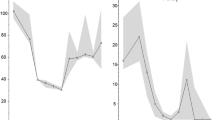Summary
Recent animal research has provided evidence that brain ischaemia is associated with a shift of energy related metabolites (lactate, adenosine, inosine, and hypoxanthine) and several transmitters from the intracellular to the extracellular fluid (ECF). These chemical changes of the ECF reflect the energy crisis of the ischaemic tissue. We have proposed that measurement of these metabolites in the ECF using microdialysis may be a useful technique for detection of secondary ischaemia in neurosurgical intensive care patients. As a first step in the evaluation of such a possible clinical application of microdialysis the aim of this study was to measure energy related metabolites and amino acid transmitters during cerebral ischaemia in man. Microdialysis probes were inserted in tumour-free cortical tissue in the frontal lobe in patients undergoing frontal lobe resection as a treatment for brain tumours. Dialysis samples were collected in 10 minutes fractions before and during frontal lobe resection, thus serving as a simulated ischaemia model. The resection procedure was associated with markedly elevated levels of the energy related metabolites as well as transmitter amino acids. The tissue surrounding the probes was examined histologically, and the degree of oedema was estimated from CT scans. In two of the patients the tissue hosting the probes was oedematous. These patients had markedly higher basal levels of lactate. The main conclusions were (1) that the results support the clinical potential of microdialysis, (2) that lactate may be a sensitive indicator of the metabolic disturbances associated with brain oedema, and (3) that frontal lobe resection may be a useful human brain ischaemia model.
Similar content being viewed by others
References
Benveniste H, Drejer J, Schousboe A, Diemer NH (1984) Elevation of the extracellular concentrations of glutamate and as partate in rat hippocampus during transient cerebral ischemia monitored by intracerebral microdialysis. J Neurochem 43: 1369–1374
Bolander HG, Persson L, Hillered L, d'Argy R, Pontén U, Olsson Y (1989) Regional cerebral blood flow and histopathologic changes after middle cerebral artery occlusion in the rat. Stroke 20: 930–937
Fredholm BB, Sollevi A (1981) The release of adenosine and inosine from canine subcutaneous adipose tissue by nerve stimulation and noradrenaline. J Physiol (Lond) 313: 351–367
Hagberg H, Lehman A, Sandberg M, Nyström B, Jacobson I, Hamberger A (1985) Ischaemia-induced shift of inhibitory and excitatory amino acids from intra- to extracellular compartments. J Cereb Blood Flow Metab 5: 413–419
Hagberg H, Andersson P, Kjellmer I, Thiringer K, Thordstein M (1987) Extracellular overflow of glutamate, aspartate, GABA, and taurine in cortex and basal ganglia of fetal lambs during hypoxia-ischemia. Neurosci Lett 78: 311–317
Hallström Å, Carlsson A, Hillered L, Ungerstedt U (1989) Simultaneous determination of lactate, pyruvate and ascorbate in microdialysis samples from rat brain, blood, fat and muscle using high performance liquid chromatography. J Pharmacol Meth 22: 113–124
Hillered L, Persson L, Bolander HG, Hallström Å, Ungerstedt U (1988) Increased extracellular levels of ascorbate in the striatum after middle cerebral artery occlusion in the rat monitored by intracerebral microdialysis. Neurosci Lett 95: 286–290
Hillered L, Hallström Å, Segervärd S, Persson L, Ungerstedt U (1989) Dynamics of extracellular metabolites in the striatum after middle cerebral artery occlusion in the rat monitored by intracerebral microdialysis. J Cereb Blood Flow Metabol 9: 607–616
Hillered L, Persson L, Pontén U, Ungerstedt U (1989) Chemical changes in the extracellular fluid of human cerebral cortex during ischemia measured by intracerebral microdialysis. J Neurochem 52: S 55 B
Jørgensen MB, Diemer NH (1982) Selective neuron loss after cerebral ischemia in the rat: possible role of transmitter glutamate. Acta Neurol Scand 66: 536–546
Lindroth P, Mopper K (1979) High performance liquid chromatographic determination of subpicomole amounts of amino acids by precolumn fluorescence derivatization with ophthaldialdehyde. Anal Chem 51: 1667–1674
Persson L, Hårdemark H-G, Bolander H, Hillered L, Olsson Y (1989) Neurologic and neuropathologic outcome after middle cerebral artery occlusion in rats. Stroke 20: 641–645
Phebus LA, Perry KW, Clemens JA, Fuller RW (1986) Brain anoxia release striatal dopamine in rats. Life Sci 38: 2447–2453
Rothman SM (1983) Synaptic activity mediates death of hypoxic neurons. Science 220: 536–537
Rothman SM (1984) Synaptic release of excitatory amino acid transmitter mediates anoxic neuronal death. J Neurosci 4: 1884–1891
Simon RP, Swan JH, Griffith T, Meldrum BGS (1984) Blockade of N-methyl-D-aspartate receptors may protect against ischemic damage in the brain. Science 226: 850–852
Tossman U, Ungerstedt U (1986) Microdialysis in the study of extracellular levels of amino acids in the rat brain. Acta Physiol Scand 128: 9–14
Ungerstedt U (1984) Measurement of neurotransmitter release by intracranial dialysis. In: Marsden CA (ed) Measurement of neurotransmitter release in vivo. John Wiley & Son Ltd, pp 81–105
Wieloch T, Lindvall O, Blomqvist P, Gage F (1985) Evidence for amelioration of ischemic neuronal damage in the hippocampal formation by lesions of the perforant path. Neurol Res 7: 24–26
Author information
Authors and Affiliations
Rights and permissions
About this article
Cite this article
Hillered, L., Persson, L., Pontén, U. et al. Neurometabolic monitoring of the ischaemic human brain using microdialysis. Acta neurochir 102, 91–97 (1990). https://doi.org/10.1007/BF01405420
Issue Date:
DOI: https://doi.org/10.1007/BF01405420




